Out and about after the 405 reopens
July 13, 2011
Nothing like taking the 405 Freeway out of commission to put a crimp in L.A.’s weekend plans. But just because you’re being a good citizen and hunkering down during Carmageddon doesn’t mean you have to stay put once the weekend’s over. Here are some outings that are sure to cure your cabin fever once the work week begins.
UCLA Hammer Museum
Human rights activist John Prendergast speaks about his mentoring experiences in the Big Brothers program at the UCLA Hammer Museum on Tuesday, July 19, at 6 p.m. Prendergast recently wrote a book about how his 25-year relationship with his “little brother” transformed both of their lives. The free lecture is part of a series called “Zócalo at the Hammer,” which focuses on important social issues of our times. Tickets and details about the lecture are available on the website.
Also at the Hammer, up-and-coming writers read from their works as the culmination of their Emerging Voices literary fellowship. Hear what they have to say on Wednesday, July 20, at 6 p.m. Five writers will perform their final readings free of charge.
Hollywood Bowl
The hilarious, tangential ramblings of comedian Eddie Izzard take center stage this Wednesday, July 20, at the Hollywood Bowl. Izzard’s irreverent stand-up has earned him a place on Comedy Central’s 100 Greatest Standup Acts of All Time, and placed him in the top 20 in a 2005 poll of fellow comedians, “The Comedian’s Comedian.” The show starts at 8 p.m. Purchase your tickets on the Bowl’s website, where you’ll also find directions.
Skirball Cultural Center
The Skirball’s closed this weekend but you can make up for lost time next week when the sounds of Cape Verde ring through the cultural center. Singer Maria de Barros starts the 2011 “Sunset Concerts” series on the right note with her Thursday, July 21, performance. De Barros’s native Cape Verde is an archipelago nation in the Atlantic Ocean about 350 miles off the coast of West Africa. Her music combines the Latin, African and French influences of Cape Verdean music with Spanish, Caribbean, and Latin American sounds. Doors open at 7 p.m. and the free concert starts at 8 p.m. Find out more on the Skirball Center’s website.
The Getty Center
Like the Skirball, the Getty will be closed this weekend. So make it a point to get up there next week, when renowned architect and urban planner Julio César Pérez Hernández animates the architecture of past, present and future Cuba in the latest installment of the Getty’s lecture series. Pérez Hernández recently led a team of Cuban architects in the creation of a new master plan for Havana, and has written extensively within the field. His free lecture accompanies the exhibition “A Revolutionary Project: Cuba from Walker Evans to Now,” which documents Cuba in photos taken before, during and after the 1959 Revolution. It begins at 7 p.m. on Thursday, July 21. Reservations are recommended, and can be made online.
Posted 7/13/11
County re-ups with Homeboy
July 13, 2011
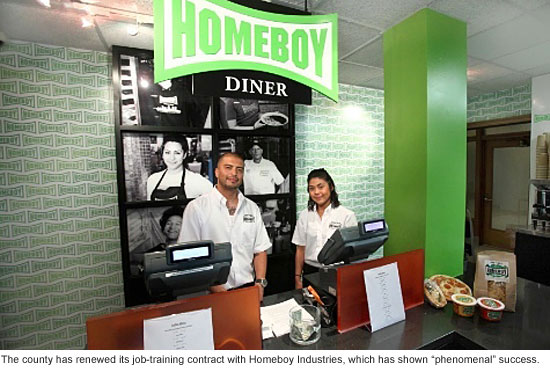 Nine months after Los Angeles County stepped in to help keep the doors open at Homeboy Industries, its contract for re-entry services has been extended, preserving a key source of job training for gang-affiliated probationers and parolees.
Nine months after Los Angeles County stepped in to help keep the doors open at Homeboy Industries, its contract for re-entry services has been extended, preserving a key source of job training for gang-affiliated probationers and parolees.
The Board of Supervisors on Tuesday voted to renew the county’s $1.3 million agreement with Homeboy, which originally had been approved as a 9-month pilot project.
The public money will pay for 12 more months of job training, tattoo removal, legal counseling and other services for more than 600 county probationers and parolees between the ages of 14 and 30. It also will continue to fund 20 to 30 revolving job trainee positions at Homeboy businesses, along with an ongoing outside evaluation of the program’s effectiveness.
Although the final evaluation of the joint venture’s first nine months won’t be complete until August, the social scientists conducting it say Homeboy’s success rate appears to be strikingly higher than the national average.
UCLA adjunct professor Jorja Leap said preliminary data shows approximately 80% of the county-funded trainees to be either fully employed or still enrolled in the Homeboy program at the end of the initial 9-month contract, with only about 10% back behind bars. The national rate of re-incarceration among gang members is about seven times higher than that, Leap says.
“This is all very cautionary and short term, and with the contract renewed, we’ll be able to learn even more,” she says. But if the numbers hold up, “it’s absolutely phenomenal.”
Founded in 1992 by the Rev. Greg Boyle, a Jesuit priest, Homeboy Industries is the nation’s largest gang intervention program. Operating under the slogan, “Nothing stops a bullet like a job,” the organization operates a bakery, two cafes, a silk screening and embroidery shop and a janitorial company, among other endeavors.
The organization also is known for its tattoo removal program—a prosaic but potentially life-altering service that annually eliminates a crucial job impediment for thousands of repentant gang members. Boyle has said Homeboy’s job training, educational, legal and mental health services help some 12,000 at-risk youths and young adults every year.
Boyle has noted that Homeboy has served for years as the county’s unofficial—and largely un-reimbursed—“after-care and re-entry program for gang members.” According to Leap’s preliminary numbers, Homeboy’s client base is overwhelmingly, if not entirely, made up of county probationers and parolees who came to Homeboy on their own initiative.
The county also runs various re-entry programs for ex-inmates, but the demand for help far outstrips the supply, says Cal Remington, chief deputy of the county’s Department of Probation. So when a financial shortfall last year forced the organization to lay off hundreds of staffers, Homeboy turned to the county as a natural ally.
“This is really a public safety issue for the county,” says Homeboy’s Chief Operating Officer Veronica Vargas. “You can’t expect someone who has never held a job to walk back into society and know how to get hired.”
Remington calls Homeboy “a good resource,” particularly in light of the state’s desire to shift responsibility to the county for thousands of non-violent parolees, who “still tend to need a lot of resources wrapped around them…Homeboy is legitimate, and has credibility in the community, so I think they could have a real role to play.”
Posted 6/28/11
Our Carmageddon cheat sheet
July 13, 2011
 After months of preparations and weeks of dire prognostications, the 53-hour closure of the 405 Freeway is finally upon us. Whether L.A. faces Carmageddon this weekend or witnesses a benign replay of the traffic-lite1984 Olympics, knowing a few basics will help you successfully navigate the shutdown.
After months of preparations and weeks of dire prognostications, the 53-hour closure of the 405 Freeway is finally upon us. Whether L.A. faces Carmageddon this weekend or witnesses a benign replay of the traffic-lite1984 Olympics, knowing a few basics will help you successfully navigate the shutdown.
Beyond adopting the official mantra of “plan ahead, stay home, avoid the area,” here’s a short list of things you really need to know.
What’s happening when
As part of the $1.034 billion project to add a 10-mile northbound carpool line and other improvements to the 405 Freeway, on-ramps to the 405 between the 10 and 101 will begin closing at 7 p.m. on Friday, July 15. Traffic lanes will start closing at 10 p.m. Friday, and the freeway is scheduled to shut down completely at midnight. It is scheduled to remain closed all of Saturday, July 16, and Sunday, July 17. The closure, needed to demolish the south side of the Mulholland Bridge over the freeway, is scheduled to wrap up by 5 a.m. on Monday, July 18, with the freeway reopening to traffic at 6 a.m. The project website has more information.
What’s closed
The northbound 405 Freeway will be closed from the 10 to the 101. The southbound 405 will be closed from the 101 to Getty Center Drive. Sepulveda Boulevard is designated for local access only, and officials are strongly urging non-residents to stay away (although IDs will not be checked to verify residency). Canyon roads are expected to be clogged and gridlock could seriously affect freeways across the region—not just those on the Westside and in the San Fernando Valley—so don’t travel unless you really need to. (Here are some tips for making the best of it close to home.) And please note—The Getty and the Skirball Cultural Center are both closed all weekend.
Check out the detour maps
Getting around will likely be a challenge, no matter where you are in the region. If you must drive, here are the official detour maps.
Who to call in an emergency
As always, dial 911. Officials of the “unified command” overseeing public safety during the closure considered establishing a special number for nearby residents to call but decided that the capabilities of the 911 system (which can trace dropped calls and record all communications) made it the best way to go. For more on the emergency response plans, read this.
What to know before heading to LAX
This webpage provides valuable information for anyone who needs to get to or from the airport. Allow plenty of time, and plan ahead.
How to contact the project hotline
The 405 project hotline, (213) 922-3665, will be monitored all weekend. This is not the number to call in an emergency, or for driving directions, but is a good way to bring other matters to the attention of the project’s community relations staff. If you’d prefer to e-mail, contact information is on the project website.
Staying on top of traffic conditions
For real time traffic conditions, check out Go511.
Keeping up with developments on Twitter and Facebook
Get up-to-the-minute updates on Twitter. (Search for #405Official.) The project website is here and its Facebook page is here.
How to get a free ride on public transportation
Many Metro trains and buses will be free throughout the weekend, and extra service is planned. Read all about it here.
From the Valley to the beach—by bus
Just because the freeway’s closed doesn’t mean the beach is out of reach. Travelers from the San Fernando Valley and Topanga Canyon can ride the Topanga Canyon Summer Beach Bus to Topanga, Will Rogers and Santa Monica state beaches both days this weekend. The cost is 50 cents each way, with seniors and the disabled paying a quarter. The pickup and drop-off times and locations are here. The Topanga beach bus is adding special Sunday service this weekend to help offset the effects of the 405 Freeway closure. (Summer beach service from some other parts of the county is being suspended for the weekend; check the Department of Public Works website before making plans.)
What’s exactly happening out there anyway?
This detailed explanation of the demolition plans, posted on Metro’s blog The Source, gives a good sense of what will be going on while the freeway is closed. And in this live chat last month, officials explained why the Mulholland Bridge’s design—a steep single span with no center column—makes the full weekend closure necessary for safety reasons.
When do we get to do this again?
Mark your calendar: in about 11 months or so, demolition of the north side of the Mulholland Bridge is set to take place— which means another long freeway closure coming in 2012.
Posted 7/13/11
Good start for new L.A. River project
July 13, 2011
 Weedy and industrial, the concrete channel near the football field at Canoga Park High School scarcely looks like a notable site.
Weedy and industrial, the concrete channel near the football field at Canoga Park High School scarcely looks like a notable site.
But the spot where Calabasas Creek meets Bell Creek—be it ever so humble—is actually a landmark: the beginning of the Los Angeles River. And this week, it came a big step closer to getting the kind of makeover that would allow it to finally shine.
The Board of Supervisors accepted a $1.97 million state grant to help launch construction of the Los Angeles River Headwaters Project, which eventually will create more than a mile of recreational trails at the point where the storied urban river starts near Canoga Park High School in the San Fernando Valley.
Tentatively scheduled for completion in 2013, the Headwaters Project is part of a larger plan to reclaim and revitalize the river, which runs for some 50 miles through 13 cities, including Los Angeles, before it empties into the ocean at Long Beach. (Click here for an artist’s rendering of the project.)
The grant, authorized under the Proposition 84 state park program and awarded by the California Natural Resources Agency, will be a substantial down-payment on the headwaters improvement, which is expected to add some $9.3 million worth of pedestrian paths, landscaping, signage, water quality improvements and decorative fencing to an area now closed to the public and mostly used for flood control and maintenance.
Officials from the county Department of Public Works say it is the first of several grants for which they’ve applied in the hope of mitigating the cost of the project. And, they note, the City of Los Angeles has applied for an additional Metropolitan Transportation Authority grant to add a bike path to the area.
“Right now, it doesn’t look like a place anyone would want to visit,” says Terri Grant, principal engineer for the county Department of Public Works.
“But when it’s done, it will enhance the community, and draw people to a new area of open space where they can enjoy themselves and relax.”
Posted 7/13/11
53 ways to survive without the 405
July 13, 2011
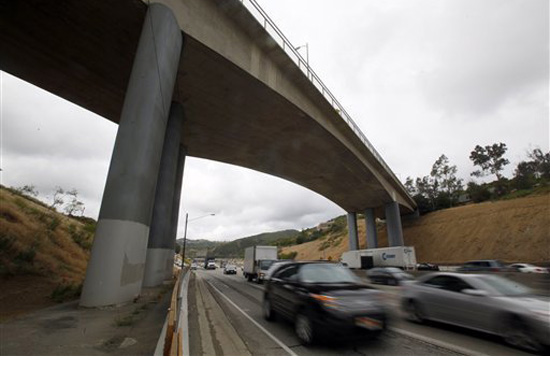
Editor’s note: These tips from the original Carmageddon could still be useful this time around. The dates have changed, of course; the 405 closure is Sept. 29-30.
In case you haven’t heard, official Los Angeles wants you to get out of town the weekend of July 15-18, or to make it a stay-close-to-home time as demolition of the Mulholland Bridge shuts down the 405 Freeway. For those of you planning to tough it out here in L.A., we asked some of our county colleagues to help us compile tips for turning 53 hours of Carmageddon fever into some good communal karma. Here’s what we came up with:
Hunkering down

1. Honor the demise of the Mulholland Bridge by holding a mini-film festival of movies from 1960, the year it was completed. Some classic options include “Psycho” and “Spartacus.” Or see how far you can get, screening your way through AFI’s list of America’s 100 Greatest Movies.
2. Continue the mid-century theme by making a playlist that includes 1960 hits such as “It’s Now or Never” and “Only the Lonely.”
3. Adopt a pet from a local animal shelter, and spend the weekend introducing your newest family member to your home and neighborhood. Locate a nearby L.A. County shelter here; call ahead to find out whether they have animals ready for same-day adoption.
4. Dust off some old board games and hold a Clue, Scrabble or backgammon marathon. At least that little Monopoly car will still be able to zip around the board, even if the rest of Southern California is stuck in a weekend-long Sigalert.
5. Plan your next vacation(s).
6. While away a few hours perusing the Los Angeles Public Library’s digital collections of old movie posters, travel posters, fruit crate labels and photographs. (Just type in a keyword such as “Hollywood” and a year span of, say, 1959-1960, and start feasting your eyes on some amazing shots.)
7. Join Los Angeles Times architecture critic Christopher Hawthorne in his yearlong “Reading L.A.” project. The July titles include “The History of Forgetting: Los Angeles and the Erasure of Memory” and “Holy Land: A Suburban Memoir.”
8. Get an early jump on your holiday shopping without getting out of your pajamas by patronizing some of these L.A. County online stores.
9. Get organized, and do some good at the same time: Clean out your pantry and donate non-expired canned goods to a food bank. Go through closets for items to give to a charitable thrift shop. Gather up loose change and earmark the proceeds for a cause you care about.
10. Take this quiz and see if your kitchen could earn an “A” from county public health inspectors.
11. Make sure you have emergency kits in your car and at home. Check out the Department of Public Health’s emergency preparedness site for its list of 10 essential items. Update your family emergency preparedness plan and practice it. And while you’re at it, check out the county Fire Department’s fire prevention resources, too.
Building community

12. If you have a pool, invite your neighbors over for a swim and an outdoor movie.
13. Go door-to-door and collect neighbors’ phone numbers and email contacts for an emergency phone tree.
14. Organize a block party.
15. Buy a large canvas and set it on an easel in front of your house along with paints, brushes and a sign asking passersby to get artistic.
16. Enlist your neighbors in a community walking group.
17. Start a Neighborhood Watch group.
18. Drop by your local fire, police or sheriff’s station and say hello.
19. Take an interest in where your neighborhood lands in the county’s redistricting process by weighing in here. The Board of Supervisors is expected to adopt a redistricting plan by August, 2011.
20. Make a list of 10 people you haven’t spoken to in a long time and call them to say hello. Better yet, surprise each of them with a handwritten letter.
21. Check in on a sick or elderly neighbor and offer your services in the yard, kitchen or laundry room, or as an errand-runner for the afternoon. A ride to religious services might be appreciated, too.
22. Form a neighborhood group to ride in the new northbound 405 carpool lane that will stretch from the 10 to the 101 when the Sepulveda Pass project wraps up in 2013…and share the gain that comes after the pain.
Out and about

23. Be the first on your block to experience the Natural History Museum’s spectacular new Dinosaur Hall, which opens July 16. Public transportation options are probably best; find them here.
24. Frolic in a local park. Los Angeles County has more than 150 of them, so pack your Frisbee and a picnic and enjoy the summertime weather with your family. More information about park locations and amenities is here.
25. Get a library card. Or, if you already have one, make it a point to drop by over the weekend and learn about opportunities for volunteering or donating.
26. Get a group together for a Metrolink daytrip. San Juan Capistrano, anyone? Check out the station map here for other possible destinations.
27. Plug your address into www.walkscore.com and find out how walkable your neighborhood is. Then start hoofing it.
28. Patronize locally-owned businesses. (Many will show up, along with other amenities such as parks, on Walk Score, above.)
29. Take a hike. Trail systems in Los Angeles range from easy strolls to challenging hillsides. Find one that’s close to you.
30. Hit the links at a county golf course. Skip the cart rental and enjoy the walk.
31. Stock up on healthy fruits and vegetables at your local farmers market.
32. Grab your camera and head out in search of your neighborhood’s most distinctive features, from lampposts and architecture to flowerbeds and wildlife. Share your photos on Supervisor Yaroslavsky’s website.
33. Whether your taste in entertainment runs more to “Shrek The Musical” at the Pantages or Sarah McLachlan at the Hollywood Bowl or “Les Misérables” at the Ahmanson, there’s a way to get there by public transportation. And this is just the weekend to give it a try.
Make it a green weekend

34. Tear out your lawn and replace it with native plants.
35. Plant a tree. Or outsource the work to TreePeople, in honor of someone you love.
36. Start a garden. The benefits—fresh air, exercise—will go well beyond the tasty vegetables and herbs you’ll harvest. Tips are here.
37. If you’ve already got a garden, host a garden party (fancy hats optional) and send everybody home with a cutting.
38. Organize or join a produce-sharing cooperative on your block…and start off by pooling backyard lemons and making a giant batch of lemonade for everyone to share.
39. Start a backyard compost pile. (Read up first on all the benefits here.)
40. Get in line for some green by signing up your house for Energy Upgrade California at www.lacountyenergyprogram.org
41. Calculate your home’s solar energy potential.
42. Grab your reusable shopping bags and flaunt them everywhere you shop in honor of the county’s new plastic bag ban.
43. If you live near the beach, or can get there on the bus, take to the sand and help clean it up. For a list of more organized clean-up activities, look here.
44. Find out how and where to get rid of used motor oil or old computers and other “e-waste.”
45. Install some eco- and design-friendly rainbarrels to store rainwater from your roof for future use. (More information starts on Page 27 of this county manual.)
Go car-free for a day—or forever
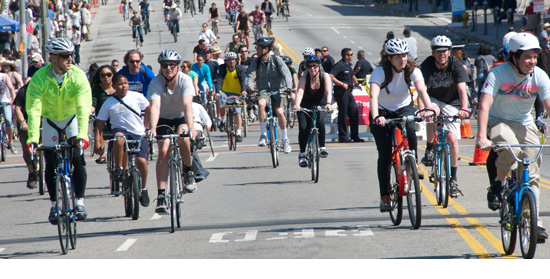
46. Ride the subway for free all weekend long. Update: There are no free rides for Carmageddon II.
47. Explore a wealth of summer destinations on public transportation.
48. While you’re riding, check out the art. Or really save energy and check out Metro’s art virtually.
49. Go out to eat without guzzling gas. The possibilities range from pastrami to rice porridge on Metro’s Dining Map.
50. Help plan and promote the next car-free CicLAvia.
51. Look up the bike trail that’s nearest to your house, and give it a try. Detailed path maps are here.
52. Get a pedestrian’s eye view of L.A. history by following one of these self-guided Angel’s Walk itineraries. Other downtown walks are here.
53. Practice riding your bike to work …and then when Monday rolls around, really do it. And congratulations, you made it through 53 hours without the 405 Freeway!
Posted 6/15/11
The sheriff vs. the probation chief
July 12, 2011
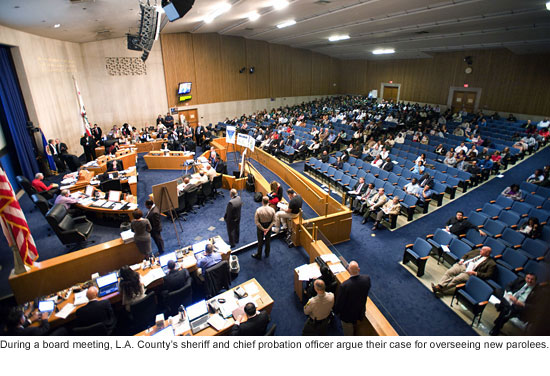 Two of Los Angeles’ most powerful criminal justice agencies faced off Tuesday during an extraordinary meeting of the Board of Supervisors, each arguing that they’d be better equipped to handle the surge of parolees who’ll soon be flowing into the county as a result of the state’s budget crisis.
Two of Los Angeles’ most powerful criminal justice agencies faced off Tuesday during an extraordinary meeting of the Board of Supervisors, each arguing that they’d be better equipped to handle the surge of parolees who’ll soon be flowing into the county as a result of the state’s budget crisis.
Under Gov. Brown’s “realignment” spending plan, California’s counties are being given responsibility for overseeing thousands of low-level state prison inmates who will be released to ease prison overcrowding and to save money. Although the state has agreed to provide funding to the counties for the first year, there are no guarantees beyond that.
Virtually everywhere else in the state, county probation departments have been tasked with these new duties, which are similar to those they already perform. But in Los Angeles, Sheriff Lee Baca has offered a novel and controversial proposal, contending that the public safety mandate of his department should be broadened to include the rehabilitative work of parole supervision.
On Tuesday, Baca took on Los Angeles County’s Chief Probation Officer Donald Blevins, who argued that his agency is not only more qualified to oversee the new parolees but that it can do so at a better price for taxpayers. The Board of Supervisors’ hearing room was crowded largely with Probation Department supporters.
The supervisors, who had strongly opposed Brown’s realignment proposal, challenged the two agency leaders to defend the content and cost of their proposals. Some expressed concerns that neither department—both of which have come under federal scrutiny for facets of their operations—could deliver on its promises. Several supervisors suggested that a hybrid of the two agencies should be considered. In the end, the board asked the Chief Executive Office to report back with an analysis of the competing proposals.
Critics of Baca’s bid contend that the Sheriff’s Department has no institutional expertise in overseeing parolees, a job more akin to social work because of its emphasis on reintegrating ex-prisoners into society. But the sheriff pointed to his record as a leading advocate for inmate rehabilitation and his department’s success in working with community-based re-entry programs.
“My department has the largest education-based incarceration program in the nation,” he said.
At the same time, Baca argued that the reach of his department could help protect the public from problems that might arise from such a large number of former inmates suddenly returning to live in Los Angeles County.
“This is a seven-day-a-week, 24-hour-a-day problem, and therefore resources must be dedicated to ensure that felons in the system understand we have the capacity to supervise them any time, any place, any time relative to the week,” Baca said.
Chief Probation Officer Blevins, for his part, acknowledged that his department has been plagued by problems in its juvenile camps. But he emphasized that it has an excellent record in supervising adults, many of whom are ex-felons and account for more than 70% of the department’s workload.
“We have a proven track record of working with this population,” Blevins said. Moreover, he said, the Probation Department could better comply with a legal mandate encompassed in the state legislation requiring the county to use “evidence-based” practices to reduce recidivism among state parolees. One probation program for probationers aged 18-25 at a county day reporting center has cut recidivism from 39% to less than 22%, he said.
The Probation Department’s plan, he said, “does not focus on suppression and incarceration over rehabilitation…It does not complicate and confuse the clients in terms of the roles and responsibilities of officers. It does not require building, learning and training to a brand new infrastructure that potentially can take years to implement and operate efficiently.”
Although the supervisors did not vote on the matter, several seemed openly wary of Baca’s plan, especially given its higher one-year cost estimate–$37 million versus $28 million for the Probation Department.
Supervisor Zev Yaroslavsky, for one, suggested that the board might not even be considering Baca’s proposal were it not for his reputation as one of law enforcement’s most forward-thinking figures.
“You’re unique, Lee,” the supervisor said told the sheriff. “The only reason this has been given the time of day is because you’re proposing it. If this had come from just about anybody else in law enforcement, I don’t think it would have been given serious consideration.”
Posted 7/12/11
Homeboy counting on a comeback
July 12, 2011
Last May, Homeboy Industries was in serious peril. The recession and a costly expansion had crippled the renowned gang intervention program financially. Three-quarters of its staff had been laid off and Father Gregory Boyle, Homeboy’s Jesuit founder, was relying on volunteers just to keep the doors open.
What a difference a year can make.
With a push for federal funding, a barrage of new initiatives, and—crucially—a key $1.3 million contract from Los Angeles County, “we’re still struggling, but we’re back on our feet,” says Veronica Vargas, Homeboy’s chief operating officer.
Not that they’re unscathed. The organization is accepting only about half the in-house job trainees it used to. Health insurance has been cut for trainees in its Chinatown headquarters. The waiting lists for tattoo removal, mental health care and other services are so long, “we’re doing triage,” says Vargas.
But in the past year, Homeboy, which says it helps 12,000 gang members a year with educational, mental health, legal and job training services, has not only dramatically ramped up its business, but also begun to see the fruits of a county-funded initiative to objectively measure the success of its programs.
“I’ll be blunt—so far, it’s not at all what I expected,” says Jorja Leap, one of two UCLA School of Public Affairs scholars who have been monitoring Homeboy both for a separate longitudinal study and as part of the county’s 9-month contract.
Since September, at the county’s behest, Homeboy has been providing job counseling and development, mental health care, tattoo removal and other services for 665 probationers and other high-risk individuals between the ages of 14 and 30. This week, Leap and her colleague, Todd Franke, submitted the second of three progress reports to the county.
Six months into the contract, Leap says, demand has been strong—and growing, particularly among county probationers and parolees under 30. Early figures show that about 100 county clients per month have volunteered for tattoo removal, and about 300 a month have been taking advantage of Homeboy’s employment counseling services. Another 150 or so each month have attended life skills, GED, 12-step and other classes.
Those numbers—and that word “volunteer”—are important because they reflect the extent to which the county might, over time, reduce duplication between Homeboy and its own gang re-entry programs.
Cal Remington, chief deputy of the county’s Department of Probation, says the reports have been encouraging so far, and Homeboy’s success is well-known, but savings ultimately could be limited.
 For example, he says, most Homeboy programs are based on the belief that people don’t change unless they want to, and the organization “wants people to come on their own.” But probation and parole are, by their nature, involuntary. Many probationers and parolees do seek out Homeboy, he says, but unless the entire county caseload volunteered, some would still require county-run re-entry programs.
For example, he says, most Homeboy programs are based on the belief that people don’t change unless they want to, and the organization “wants people to come on their own.” But probation and parole are, by their nature, involuntary. Many probationers and parolees do seek out Homeboy, he says, but unless the entire county caseload volunteered, some would still require county-run re-entry programs.
“I think they provide a real service that benefits the county,” he says, “but we’re interested in finding out how many [probationers] voluntarily take advantage of that, and then how they’re doing in the community.”
Additionally, the report has tracked a smaller cohort of job trainees whose positions are also funded under the county contract.
So far, Leap says, about 50 former gang members, two-third of them male, have cycled through those 30 trainee positions. And though gang populations nationally have a 70% recidivism rate, she says, only three of the county’s Homeboy trainees have been re-arrested and none have gone back to prison so far.
On the other hand, she says, one of the 50 has now entered college, four have gone on to full-time jobs with employers outside Homeboy, about 20 have worked their way up to employment at one of Homeboy’s various businesses and another 22 or so are continuing to progress through the program.
Leap cautioned that the numbers are preliminary. And, she says, the data has not yet come in for a planned comparison with retention and recidivism rates in two county-run gang re-entry programs.
“But,” she says, “you don’t need a Ph.D to tell you that these are phenomenal, phenomenal results.”
“This is why I can’t wait for the county to see how well this program works,” exults Vargas. “Nobody back in prison? That’s huge.”
Although four outside placements and a college enrollment may not sound like much after six months, she says, just sticking with the program is an achievement for many gang members.
One young man profiled in Leap’s report had come to the Homeboy program after an 18-month stint in state prison on an armed robbery conviction. The son of a drug-addicted mother and absentee father, he had grown up in a 3-bedroom apartment shared by 30 people in the Nickerson Gardens Housing Project.
He had thrived as a Homeboy trainee, the report says, and was working with young adults just out of probation camps within three months of his arrival. But his family’s gang ties were a constant source of conflict.
“Some family members would openly mock his efforts, while other relatives would pressure him to get back involved in the streets and the gang life style,” the report says. For a while, the young man slept in his car to escape the pressure, but his struggle has been apparent.
“He continues to be an excellent worker,” according to the report, but “he has not kept all his appointments and seems very conflicted about gang involvement.”
It’s a common pattern, says Vargas. Indeed, one of the county-funded trainees—a 22-year-old who had diligently worked his way up to an office assistant job at Homeboy—was shot and killed last month at a late-night party in Hollywood during what authorities said was a gang-related argument.
According to Leap’s report, the vast majority of Homeboy’s clients are county probationers and parolees who are struggling to regain their footing. Many have spent years in and out of probation camps where, the report notes, they missed out on learning even such basic life skills as how to look employers in the eye and offer a firm handshake.
“Says Vargas: “You can’t rehabilitate someone in six months when they’ve been raised all their lives in violence.”
This, she says, is why she hopes the county will consider renewing its relationship with Homeboy when the current contract expires at the end of next month.
That may not be easy, given the county’s own struggles.
“As you know, we have our own deficit to deal with,” says Sheila Williams, who helps oversee the county’s public safety agencies for the Chief Executive Office. But, she adds, so far, there have been no complaints about Homeboy’s performance and “discussions are continuing.”
Meanwhile, Vargas says, Homeboy has been hustling.
The organization has won a federal grant that will to bring in about $400,000 a year for the next three years. Father Boyle has been on a book tour, promoting his acclaimed memoir, “Tattoos on the Heart: The Power of Boundless Compassion” ; those proceeds all go to Homeboy as well, Vargas says.
Ralph’s markets began offering Homeboy’s signature chips and salsas in its supermarkets nationally this year, and another initiative is promoting Homeboy products at farmers’ markets.
The conviction of KB Home’s former chief executive, Bruce Karatz, on charges that he lied about backdating stock options resulted in an unusual sentence in which Karatz—who in the run-up to his trial had already pledged $1.1 million to the organization—would bring his experience and contacts to bear as an unpaid Homeboy consultant. Vargas says they’ve only received about $200,000 of the pledge so far, but credits Karatz with the nailing the Ralph’s salsa deal in just a few phone calls after years of conversations.
And City Hall will soon be getting a new Homeboy café.
“We’re doing everything we can think of,” Vargas says. “We have to. You should see our waiting list.
“There are hundreds of people coming through our doors every month, asking for employment, and right now, we can’t provide it for them.”
Posted 5/5/11
Hall of Justice to reopen in 2014
July 10, 2011
 Los Angeles’ long-slumbering Hall of Justice just moved closer to a 2014 reawakening as a new home for the Sheriff’s Department and members of the District Attorney’s staff.
Los Angeles’ long-slumbering Hall of Justice just moved closer to a 2014 reawakening as a new home for the Sheriff’s Department and members of the District Attorney’s staff.
The storied 1925 building, which played host to some of L.A.’s most famous and infamous figures, from Charles Manson and Sirhan Sirhan to Marilyn Monroe after her death, has been closed since the Northridge earthquake in 1994.
Since then, workers have virtually gutted the space to set the stage for the hall’s revival. On Tuesday, the Board of Supervisors approved a design-build contractor, Clark Construction Group California LP, to finish the job.
The board’s action set the budget for the project at $231,785,000. Long term bonds were issued to fund the project in November. A report submitted to supervisors said the debt service on the bonds would be more than covered by lease savings realized by moving staff into the rehabilitated building. Over 30 years, the net lease savings would be $160,300,000, the report said.
When finished, the building will feature 308,000 square feet of office space and a 1,000-space parking structure.
Clark is set to begin design-build work next month. The report said the company has offered to upgrade the finished building’s environmental ranking from LEED Silver to LEED Gold at no additional cost to the county.
To get a look at the Hall of Justice’s historic interior as it awaits transformation, check out this flashlight tour.
Posted 7/12/11
Start mapping your 405 getaway
July 8, 2011
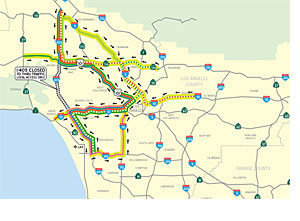 The latest ramp closure and detour maps for the 53-hour shutdown of the 405 Freeway have been finalized and feature a Sepulveda Boulevard route through the closure zone that will be designated for locals only.
The latest ramp closure and detour maps for the 53-hour shutdown of the 405 Freeway have been finalized and feature a Sepulveda Boulevard route through the closure zone that will be designated for locals only.
The four maps include a regional overview showing how the closure will affect freeways throughout Los Angeles County, up-close views of specific ramp closures (one for the northbound freeway and the other for the southbound) along with a detour map indicating recommended routes around the segment of the 405 that will be closed so workers can demolish the south side of the Mulholland Bridge over the freeway.
Notably, Sepulveda Boulevard between the 10 and 101 Freeways is marked as being closed to through traffic and will be designated as reserved for local access only, according to the draft map. However, Ron Macias, a community relations officer for the project, said there are no plans to check IDs to ensure that only residents are using the street. “We cannot prevent anyone from using Sepulveda, but it’s going to be gridlocked,” he said, noting that Metro is strongly encouraging motorists to stay far away from the area.
Ramps will begin closing around 7 p.m. on Friday, July 15. The entire freeway will be closed all of Saturday, July 16, and Sunday, July 17. It is expected to be reopened by 5 a.m. on Monday, July 18.
Posted 6/2/11





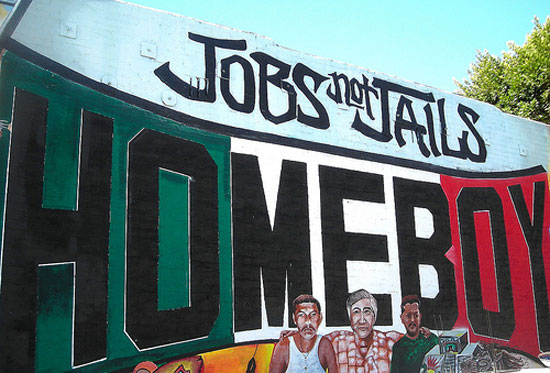

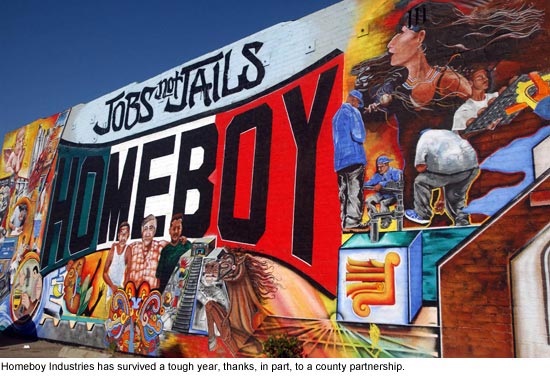





 Check for the latest closure information
Check for the latest closure information








